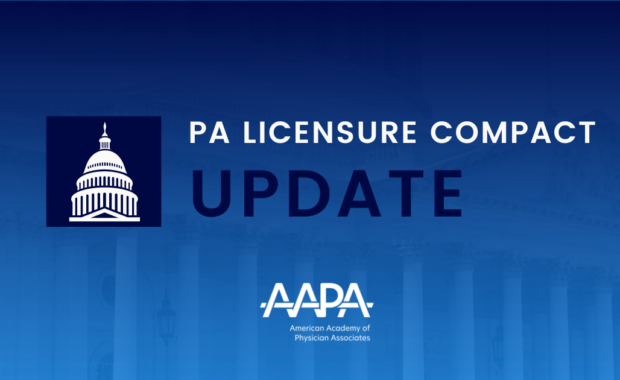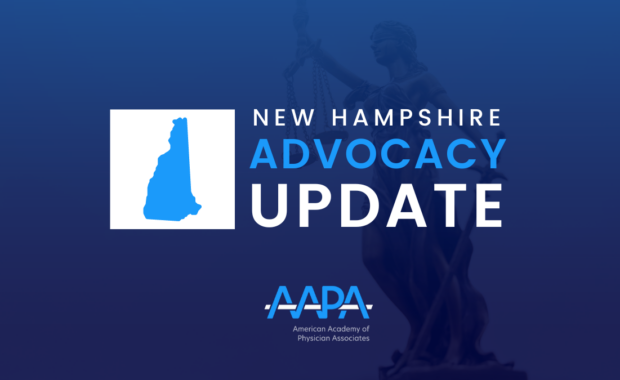What PAs Need to Know About Malpractice Insurance
Make Sure You’re Protected
December 7, 2020
All clinically practicing PAs should carry professional liability coverage, often called malpractice insurance, during all time periods in which they practice. But the ins and outs of malpractice insurance can be confusing – how much coverage do I need? What if my employer has a policy already? We have the answers to nine of your most frequently asked questions.
[Enjoy all the perks of AAPA membership – join or renew today]
How much coverage should I have?
Liability limits depend on a number of factors and are a personal decision. Though CM&F offers policy limits up to $2 million per claim, they typically recommend liability protection of $1 million per claim. With that said, there are still many factors that impact this choice, including cost and state regulations. A quick phone call to CM&F group to discuss your options will help you better understand the type of coverage you need.
How much will individual coverage cost me?
The range for PA liability insurance is great; policies can range from $1,000 for a PA practicing part-time in family practice to almost $8,000 for a PA in a full-time surgical position. The exact cost is tailored to individual needs, so there is no one-size-fits-all cost. There are certain factors that come to play when calculating cost, such as:
- The state where you practice
- Working full time vs. part time
- How many hours you practice per week
- Your specialty
The best way to calculate cost is getting a free quote at CM&F Group, Inc. Getting a quote takes less than five minutes, and you can see what your payment options are – including monthly installments.
Why do NPs pay less than PAs?
While there is a price difference between what PAs and NPs pay for liability insurance, the reason has nothing to do with experience or training.
Nurse practitioners (NPs) have traditionally begun purchasing liability insurance as registered nurses (RNs) early in their careers. The average cost of liability insurance for an RN is approximately $100.00 per year. The cost is low because there are over one million RNs in the U.S. purchasing liability insurance (out of 4 million RNs) in addition to what their employers and hospitals provide. The result is a huge pool of premium dollars to pull from to pay claims. The more insurance premiums you have, the lower the cost of insurance because the risk is spread. As RNs progress in their careers and go back to school to become NPs, they are still included in this pool of RNs. So this helps offset the claims of NPs. Their NP malpractice premiums essentially are being subsidized by their RN colleagues.
With 140,000 practicing PAs, the profession is purchasing insurance in significantly lower numbers than NPs and RNs combined.
CM&F Group, one of the largest insurers of both PAs and NPs, is taking a new approach to how they price NP liability insurance. They are making NP loss/profit stand on its own and not be subsidized by the RN program. Over the past five years this has driven NP premiums up dramatically, and at some point in the next few years, CM&F expects the premiums paid by NPs and PAs to be much more in-line.
There’s also a change taking place in the market, where NPs and PAs are increasingly working with autonomy, and now the actuaries at insurance companies are trying to price the policies for this new risk. It will take some time, but ultimately, NPs and PAs will most likely be paying the exact same premium when they are working and doing similar duties.
What if I’m already covered by my employer?
Most employers provide some level of malpractice insurance for their employees, but the only way to know for certain is to ask for a certificate of insurance every year to confirm that you are a “named insured.”
Millions of medical professionals purchase personal professional liability insurance to prevent gaps in coverage when changing jobs and to ensure they have adequate coverage. It’s important to have personal coverage that is portable from job to job and protects your license, your personal assets, and your financial future.
It is quite common for liability insurance policies to deny the insured individual any choice in whether a claim is settled or defended. Most employers’ policies do not give PAs the right to decide which approach to take. CM&F’s policy allows the PA to decide between settlement or defense.
Another common situation is the lack of coverage when a claim is made. CM&F has heard from many PAs who take new jobs and are sued years later. Remember, malpractice claims take an average of 18 – 24 months between the incident and lawsuit. In some situations, when a claim is made, the PA discovers that their employer did not purchase tail coverage for them when they left the practice, leaving them uninsured.
Does a personal policy transfer with me if I change jobs?
Absolutely, and this is one of the main benefits of having a personal malpractice insurance policy. CM&F’s policy is portable from job to job. You have coverage wherever you are practicing.
How does malpractice insurance work in a state that has Optimal Team Practice (OTP)?
As more states begin to incorporate elements of OTP in state PA practice acts, such as eliminating the legal requirement to have a relationship with a specific physician, and as PAs begin to practice with more autonomy, malpractice insurance companies may require that PAs carry an individual insurance policy. This is yet to play out, and CM&F is still monitoring the situation. Of note, as NPs have become more autonomous, they have increased the rate at which they purchase individual policies.
Can my wealth and personal assets really be impacted by a malpractice insurance case?
The short answer is absolutely; your personal assets and wealth are at risk if you do not have adequate insurance in place. Not having malpractice insurance could lead to personal responsibility for lawsuits, loss of financial assets, and the possibility of damaging your established career.
An adverse event or outcome (even if it’s an allegation) may go to your state licensure board which can review your licensure for suspension or ramification. Or if any amounts are paid on your behalf by the employer or your malpractice insurance company, you can be reported to the National Practitioner Databank (NPDB), a federal databank of malpractice payouts that’s available to employers when they’re making decisions to hire healthcare professionals.
Professional liability insurance provides protection against a patient who claims you caused an injury. This could be a wrong diagnosis, contraindicated drug reaction, or an infraction of HIPAA privacy laws. If an event were to occur, malpractice insurance will pay the verdict instead of draining your assets and will defend you against allegations.
[You’ve Been Hacked! Lessons Learned from a Cyber Breach]
Why does AAPA partner with CM&F Group?
As a team, we have similar core values and a true commitment to the PA professional community. With years of experience and plenty of room for growth, now expanding in telemedicine, CM&F will continue to work with AAPA to continually review the policy terms and annual premiums to ensure PAs have access to the very best today’s market has to offer.
Not only that, AAPA and CM&F have partnered to offer a 10% discount on your next three-year premium when you take one of five risk management activities in AAPA’s Learning Central (courses are discounted for AAPA members).
I’d like to shop around first. Any tips?
When looking into other insurance carriers, please note that they have varying forms of regulation. The most important factor is evaluating the carrier for its financial strength. An independent rater of financial strength is A.M. Best (Best), which assigns “Excellent,” “Good,” and other designations to insurance carriers. Avoid any company with less than an “Excellent” rating, denoted by Best ratings A++ (the highest) A+, A, or A-. If a company does not carry any Best rating, this means it does not cooperate with the ratings process and should be avoided.
Visit AAPA’s Malpractice Insurance Basics page today to find out more about the value of having your own liability policy, details on how to get your own malpractice insurance coverage, and more.
You May Also Like
Malpractice Insurance Basics
You’ve Been Hacked! Lessons Learned from a Cyber Breach
Thank you for reading AAPA’s News Central
You have 2 articles left this month. Create a free account to read more stories, or become a member for more access to exclusive benefits! Already have an account? Log in.



